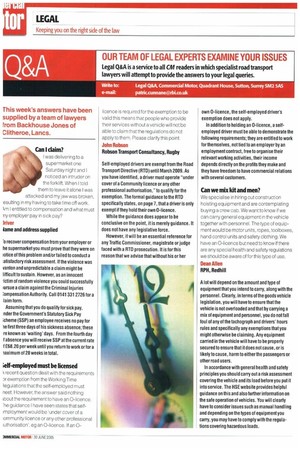Q8A-diu
Page 42

If you've noticed an error in this article please click here to report it so we can fix it.
This week's answers have been supplied by a team of lawyers from Backhouse Jones of Clitheroe, Lancs.
Can I claim?
I was delivering to a supermarket one Saturday night and I noticed an intruder on the forklift. When I told them to leave it alone I was attacked and my jaw was broken, esulting in my having to take time off work. \rn I entitled to compensation and what must fly employer pay in sick pay?
lame and address supplied b recover compensation from your employer or he supermarket you must prove that they were on lotice of this problem and/or failed to conduct a ,atisfactory risk assessment. If the violence was wanton and unpredictable a claim might be lifficult to sustain. However, as an innocent ictim of random violence you could successfully lursue a claim against the Criminal Injuries :ompensation Authority. Call 0141 331 2726 for a laim form.
Assuming that you do qualify for sick pay, nder the Government's Statutory Sick Pay 1cheme (SSP) an employee receives no pay for he first three days of his sickness absence; these re known as 'waiting' days. From the fourth day f absence you will receive SSP at the current rate f £68.20 per week until you return to work orfor a haximum of 28 weeks in total.
;elf-employed must be licensed ,ecort question dealt with the requirements Dr exemption from the Working Time iegulations that the self-employed must neet. However, the answer said nothing tbout the requirement to have an 0-licence. be guidance I have seen states that self!mployment would be 'under cover of a :ommunity licence or any other professional iuthorisation', eg an 0-licence. If an 0
licence is required for the exemption to be valid this means that people who provide their services without a vehicle will not be able to claim that the regulations do not apply to them. Please clarify this point.
John Robson Robson Transport Consultancy, Rugby
Self-employed drivers are exempt from the Road Transport Directive (RID) until March 2009. As you have identified, a driver must operate ''under cover of a Community licence or any other professional authorisation." to qualify for the exemption. The formal guidance to the RID specifically slates, on page 7. that a driver is only exempt if they hold their own 0-licence.
While the guidance does appear to be conclusive on the point, it is merely guidance. It does not have any legislative force.
However, it will be an essential reference for any Traffic Commissioner, magistrate or judge faced with a RID prosecution. It is for this reason that we advise that without his or her own 0-licence, the self-employed driver's exemption does not apply.
In addition to holding an 0-licence, a selfemployed driver must be able to demonstrate the following requirements; they are entitled to work for themselves, not tied to an employer by an employment contract, free to organise their relevant working activities, their income depends directly on the profits they make and they have freedom to have commercial relations with several customers.
Can we mix kit and men?
We specialise in hiring cut construction hoisting equipment and are contemplating buying a crew cab. We want to know if we can carry general equipment in the vehicle together with personnel. The type of equipment would be motor units, ropes, toolboxes, hand control units and safety clothing. We have an 0-licence but need to know if there are any special health and safety regulations we should be aware of for this type of use.
Dean Allen RPH, Redhill
A lot will depend on the amount and type of equipment that you intend to carry, along with the personnel. Clearly, in terms of the goods vehicle legislation. you will have to ensure that the vehicle is not overloaded and that by carrying a mix of equipment and personnel, you do not fall foul of any of the tachograph and drivers' hours rules and specifically any exemptions that you might otherwise be claiming. Any equipment carried in the vehicle will have to be properly secured to ensure that it does not cause, or is likely to cause, harm to either the passengers or other road users.
In accordance with general health and safety principles you should carry out a risk assessment covering the vehicle and its load before you put it into service. The HSE website provides helpful guidance on this and also further information on the safe operation of vehicles. You will clearly have to consider issues such as manual handling and depending on the types of equipment you carry. you may have to comply with the regulations covering hazardous loads.


































































































































































































